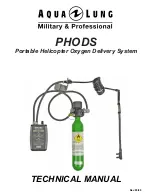
89
Batteries and Chargers
Use only the charger provided for the Lithium Ion pack (6678000). The pack can be
recharged at any time regardless of charge level. Total discharge will have a negative
impact on the number of charge/recharge cycles allowable and should be avoided. The
Lithium Ion battery can be fully charged in 8 to 12 hours using the charger provided. The
charger will terminate the charge automatically and float-charge the battery until it is
removed from the charger. The charge rate is 600 mA DC.
When the charger is plugged into a suitable AC voltage source the power LED will
illuminate. When the battery pack is connected the charge LED will illuminate yellow. A
flashing yellow charge LED indicates that the battery is deeply discharged but the charge
cycle is starting. If the flashing yellow charge LED does not stop flashing within 1 hour the
battery pack is shorted and should be disposed of properly. The battery is fully charged
when the yellow charge LED light goes off.
Temperature
Excessive heat ruins batteries. At higher temperatures, the electrical capacity that can be
taken out of a battery increases. At lower temperatures, the electrical capacity that can be
taken out of a battery decreases. Avoid placing batteries near heat sources of any kind. To
maximize battery life, operate the battery at an ambient temperature of 20 °C (70 °F). The
permissible operating temperature range is -15 to 50 °C (5 to 120 °F). Use in the 5 to 35
°C (47 to 95 °F) temperature range is recommended.
Disposal
The Lithium Ion battery pack assembly for the 940 Flow Meter is rechargeable. Follow
local applicable disposal guidelines for Lithium Ion type batteries. The entire battery
housing is meant to be disposed of after the service life of the battery. Do not attempt to
open the case to gain access to the batteries. There are no user serviceable parts inside.
Batteries and Chargers
The 940 Flow Meter may use two different types of Lithium-based battery. These batteries
require special disposal requirements and must be treated as hazardous material. Air
cargo is the only acceptable air shipment permitted. The batteries must be individually
wrapped and boxed separately. Do not puncture, incinerate or expose to water. If local
government does not allow for the disposal of these batteries contact the Hach Company
for proper disposal arrangements.
Storage
Store all battery types in a cool, dry place. A low self-discharge rate and excellent charging
characteristics permit storage of Lithium Ion batteries for up to one year without loss of
efficiency or appreciable deterioration of performance. At room temperature the
self-discharge rate of Lithium Ion batteries is approximately 1% of rated capacity per
month.
Summary of Contents for 911
Page 2: ......
Page 14: ...12 General Information...
Page 16: ...14 Getting Started...
Page 42: ...40 Meter Installation...
Page 44: ...42 Software and Communications...
Page 58: ...56 Sensor Installation...
Page 68: ...66 Maintenance...
Page 72: ...70 Replacement Parts and Accessories...
Page 76: ...74...
Page 88: ...86 Channel Installation Options...
Page 92: ...90 Batteries and Chargers...













































